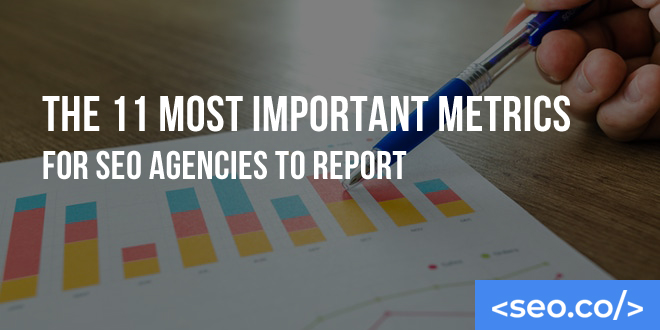As a digital marketing agency, your job is to get a client results. You work hard, getting a better understanding of your client’s competitive position and needs, and engaging in a multilayered strategy to earn them more traffic, visibility, and engagements. You might be doing an extraordinary job, but there’s one last hurdle to overcome if you want to retain your clients (and trust me, you do): you have to prove that you’re doing an extraordinary job.
There are a handful of obstacles when it comes to SEO reporting. We live in a glorious, data-driven digital age where we can track pretty much any kind of user behavior, but we’re not in the market for data—we’re in the market for insights.
Before I dig into the specific metrics you’ll want to use in your regular reporting, I need to address a few factors, complications, and principles you need to bear in mind when reporting.
- Don’t just send these metrics off and hope your client knows what to make of them. Consider yourself a guide, and err on the side of over-communicating. Schedule phone calls, or in person meetings if you have to. Your metric analysis should be a conversation, not a monologue, so be prepared to answer questions.
- Device agnosticism. Your clients’ visitors will be accessing them in many different ways, including both desktop and mobile devices. Your reporting should be as agnostic as possible, digging into one realm or another only to illustrate trends specific to that realm.
- The whys. This goes along with the communication angle, but don’t just report the “what’s—you have to report the “why”s as well. Yes, organic traffic is up 50 percent and that’s great, but what does it really mean for the client?
- Apples to apples. When reporting, you need to be as consistent as possible and only compare metrics to comparable metrics. For example, if you measure referral traffic on mobile devices one month, you have to compare it to referral traffic on mobile devices in past months.
- Long-term vision. It’s good to show growth month-over-month, and immediate returns of a client’s investment, but remember that your ultimate goal is long-term growth and value accretion to your digital marketing agency. Compare your results to the distant past, and look to the distant future when framing your results.
- Transparency and proactivity. Your results aren’t always going to be phenomenal; you’ll experience outliers, setbacks, and strange quirks in your data. Don’t try to hide these. Instead, be as proactive and transparent as possible in your reporting. This demonstrates trust, and shows that you’re giving your clients the full story, and not just an idealized view.
With those considerations in mind, I can tell you the 11 most important metrics your agency will have to report.
Table of Contents
1. Keyword Rankings.
Keywords have fallen out of style over the years, mostly thanks to various Google updates which have changed the game and made keyword-centric SEO virtually obsolete. Why virtually?
Before various Google updates, keywords were cut-and-dry. Google evaluated user queries based on their keyword content, then found “matching” websites that featured identical keyword phrases. With the Hummingbird update, it added a semantic and linguistic capacity to evaluate the “intent” behind a user’s query, and then come up with webpages that fit or address that intention. Keywords are still taken into consideration—after all, if a user is looking for “bookshelves,” the site they wind up on better talk about “bookshelves”—but they’re not at the same level of importance as they once were.
Thanks to Hummingbird, most modern businesses find that the majority of their traffic comes from long-tail phrases—conversational queries and extended searches that come naturally to the user and draw on the power of semantic search. Long-tail phrases are messy and unpredictable, making them hard to track, but you can still target and track a number of specific keyword phrases for your client.
Since Google doesn’t explicitly publish this information anymore, you’ll have to either check these ranks manually (compensating for factors like geographic location and device), or rely on a third party tool like SERPs.com.
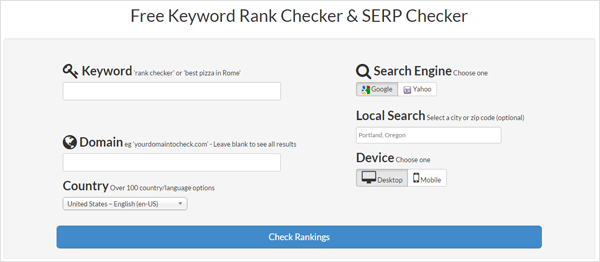
(Image Source: SERPs)
Don’t report keyword ranks as a be-all, end-all metric; it used to be one of the most important elements of a campaign, but these days, it’s a secondary consideration (mostly thanks to Hummingbird). What you’re looking for here is growth—what keywords are you ranking for that you didn’t rank for previously? How fast are your ranks climbing? These are indications of campaign momentum, and illustrate the pace and direction of your growth over time. It’s also a satisfying metric from a client perspective, as long as you explain that it isn’t the only factor worth considering.
2. Total Traffic Volume.
Even more important than keyword rankings is the total volume of traffic your client’s website is receiving. Assuming a consistent conversion rate, each new visitor to your client’s site has a value, and more visitors means more total value. It isn’t hard to equate higher traffic with more revenue, and it’s one of the most effective bottom lines you can illustrate. Higher keyword ranks don’t necessarily mean higher value, but higher traffic generally does.
However, reporting traffic gets complicated in two ways. First, you aren’t directly influencing traffic in all areas. There will be repeat visitors, direct visitors, and other forms of traffic you have no control over in addition to visitors who never would have come to the site if it weren’t for your efforts.
It’s hard to filter this down exactly, but one of the best ways is through Google Analytics. Head to the Acquisition tab and you’ll find a convenient breakdown of all the traffic headed to your client’s site. There are a few main categories here, but the four you’ll want to focus on are:
- Direct traffic. This accounts for users who type in the web address directly or access it from bookmarks.
- Organic traffic. This accounts for any users who found the site through search engines.
- Social traffic. This accounts for traffic that came from social media platforms.
- Referral traffic. This accounts for users who clicked through an external link to get to your site.
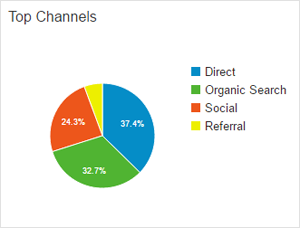
Each form of traffic here is valuable, but not all of them will be your doing. Direct traffic, for example, generally has little to do with an inbound campaign. However, your SEO efforts can take credit for all the organic traffic, and if you have an offsite link building strategy, most of the referral traffic as well. If you manage their social media presence or syndicate content there, you can claim responsibility for the social traffic as well.
Ideally, all of these forms of traffic will increase over time, giving you the opportunity to prove that your efforts have a meaningful effect. You can also drill down to each individual “segment” of traffic to glean more details of when and how these users are coming to your client’s site.

3. Backlink Quantity and Quality.
Any good SEO campaign requires a good offsite link building strategy, so naturally, you’ll want to report on the quantity and quality of links pointing back to your client’s site. There are a couple of ways to do this, but first you need to make sure your client understands the inherent “value” of a link—namely, that every link passes authority based on the authority of its source (and its context), and that it also includes the potential to refer external traffic inward.
As I’ve written before, I believe that link quality matters far more than link quantity. Given enough time, anybody can build lots of links, but it takes experience and a strong reputation to ever earn a high-authority link.
Use a tool like Moz’s Open Site Explorer to run periodic evaluations of your client’s backlink profile. Here, you’ll find a breakdown of all the links you’ve ever built (and any that were built naturally on their own), and a subjective measure of each link’s “authority.” Use these figures to illustrate the value of your work to your client.
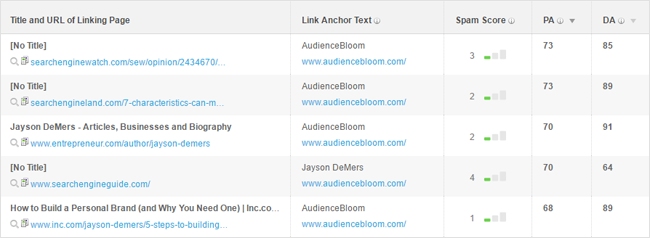
(Image Source: Moz)
Like with most of the metrics on this list, you can also use this report to fuel your own efforts; have you hit a plateau in terms of backlink authority? Do you have any low-authority backlinks lingering on that need to be taken care of? In same cases, agencies may also need to outsource their link building (typically at a discount) to a white label SEO agency in order to better scale their own link building services.
4. Page Popularity.
Page popularity isn’t a specifically defined metric within Google Analytics, but you can find a breakdown in the Behavior tab with relative ease. Here, you’ll see a breakdown of which pages are most popular within your client’s site. The default report contains only the top 10, but if you click “view full report” in the bottom, right-hand corner, you’ll see a massive list of every page with available information.
This metric is useful in a few different ways. First, if you’re doing the blog and content writing for your client, this will demonstrate just how popular your recommended topics have been. For example, if there’s a massive jump in traffic to your individual blog pages after you took over the client’s content campaign, this is clear evidence of improvement. You can also use this information to make adjustments to your content strategy once you find out what angles are and aren’t working. Second, it can help you understand how users are using the client’s site—and the Behavior Flow option is extremely useful here. Where are users going? What pages are most appealing to them?
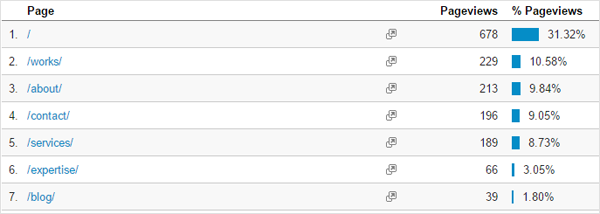
Do note that by default, this metric is reported as it relates to all traffic to your client’s site. It’s generally more useful to filter this in some way by adding a segment to your report.
![]()
For example, you might take a look at your social media inbound traffic. What do your social users find most interesting? Where do they usually land?
5. Average Time on Page.
Okay, so let’s assume you’re getting a ton of traffic for your client, but they aren’t convinced that your numbers equate to a bottom-line value. This skepticism makes sense, to a degree—after all, what good is a visit if the visitor bounces with a negative impression of the brand?

Average time on page will help you illustrate this value. As a general metric, it’s a calculation of the amount of time the average user spends on a given page of your website. You can filter this in a number of different ways, segmenting by type of traffic (as we did with page popularity) or simply looking at individual pages. There’s no “good” or “bad” amount of time here, since every industry and every site will be different, but generally, the longer a user spends on a page, the better. It means they’re soaking in more information, getting more exposure to the brand, and ultimately becoming a more valuable asset to your client. If the average time spent on a page increases over time, it’s a sign that you’re doing good work.
This gets a little tricky, since there are a number of factors that can influence this metric, and they aren’t all in your control. For example, the design and copy have a major influence on this outcome—if you’re only doing SEO work, you may not be able to make meaningful changes here. Keep this in mind when presenting this metric to the client.
You’ll also want to take a look at the “average pages per visitor” metric, which is related, but distinct. This will tell you how many pages the average visitor loaded before leaving, and is a fairly reliable indicator of overall user interest.
6. Bounce Rate and Exit Rate.
They sound the same. They’re right next to each other. And they share a lot in common, but believe it or not, these are actually separate figures. Both can give you a reasonable measure of a page’s tendency to send traffic away, indicating a lack of user interest or an inability to convert, but each one refers to a specific situation.

Bounce rate refers to visitors whose only viewed page is the page in question; for example, a user visits your About Us page as an entry, then leaves. Exit rate refers to visitors who used this page as the last in a line of sequential pages; for example, a user visits your home page, then your blog page, then your About Us page, and then leaves.
It’s important to understand this distinction because it helps you better understand your users’ intentions. For example, a high bounce rate with a low exit rate indicates this page provides useful information, but doesn’t do a good job of compelling new visitors upon entry. Obviously, your goal should be achieving lower bounce rates and exit rates over time, and you can feasibly target both simultaneously.
7. Crawl Errors and Site Status.
Depending on how much technical access you have for your clients’ sites, you may be responsible for hosting or you may just be there for content and SEO purposes. Either way, you need to be invested in the technical performance of the site. What happens if the site goes down? It may not be your direct responsibility, but it could negatively affect your client’s search visibility. Similarly, if there are 404 errors or pages missing, you need to know so you can take action.
Reporting on site status and crawl errors helps you in a couple of ways. The first is a value-add for your firm; you’ll be a kind of alarm system that will notify your client if anything goes wrong with their site. This adds a layer of comfort and security to your work, and increases client perceptions of your dedication to their brand.
The second is a representation of the work you’ve done. Assuming you’ve come in for a client who’s never done SEO before (or else hasn’t been working with professionals), there will likely be dozens, or even hundreds of errors for you to fix. Illustrating these numbers going down demonstrates the effects of the work you’re doing (especially if you can compare to figures like keyword ranks and traffic).
If you aren’t sure where to perform these diagnoses, Google Webmaster Tools has pretty much everything you need. For example, you can check out a site’s indexation status:
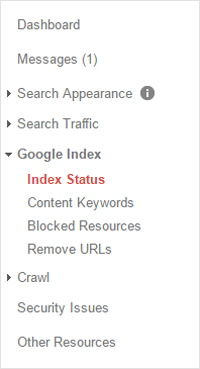
Or monitor for specific crawl errors:
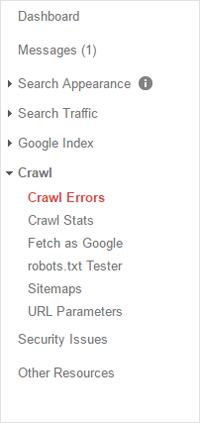
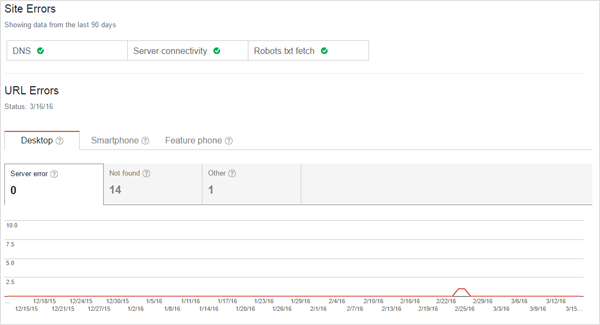
There’s a heap of other nifty tools and reports in Webmaster Tools, including a report on any lacking title tags and meta descriptions you have. It’s a good idea to take advantage of these, but they aren’t necessarily the type of thing you report to a client. Some are better for internal eyes.
8. Total Conversions.
Now we get to the real money maker of the bunch: conversions. Your role in achieving conversions may be limited (if you aren’t actively engaged in the SEO design or copywriting of a client’s landing page), but even so, it’s essential that you report conversion metrics to prove your value—I’ll get into the specific on this later.
“Conversions” can take many forms. The most basic is a customer making a purchase directly, such as buying a product from an e-Commerce website. However, almost any meaningful user action tied to potential revenue can be counted as a conversion. For example, a potential customer filling out a form for a B2B company’s contact page can be a conversion, as can watching a certain video on a page of your client’s site.
You’ll want to track all of these, so here’s how to do it. Head to the Admin tab of Google Analytics, and check out the right-most column. Here, you’ll see a section on “Goals,” Google’s way of helping you define and track customer conversions on your site.
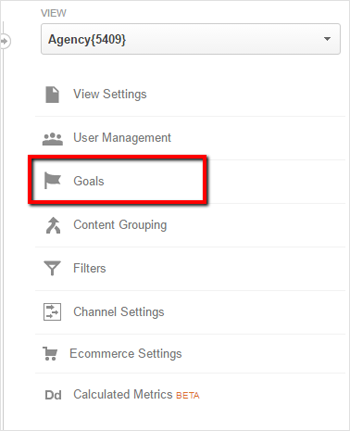
The easiest way to do this is through Google’s pre-defined templates, but feel free to create any custom Goals you need on your own. When you’re done, you’ll have a short list of Goals to track.
![]()
You can report on these individually, or as a group, and in the main dashboard of Google Analytics, you’ll have the ability to segment your traffic in a number of different ways—that way, you’ll be able to prove, definitively, how many conversions you’ve specifically influenced. This is especially important to track as you make changes to your landing pages and calls-to-action in anticipation of an improved conversion rate.
9. Value per Conversion.
This is a slight deviation from the rest of our reporting metrics on this list because it isn’t something you can influence directly; this is up to the client. However, you can help the client figure this out, and with the data, you can make a stronger case for your own effectiveness.
The value of a conversion on an eCommerce site is relatively easy to find. All you have to do is calculate the average purchase a user makes, and this fills in for your “value per conversion.” For B2B companies, this is generally more complicated. You’ll have to factor in how many leads eventually close, how long a client is retained, and possibly what the lifetime value of a customer is.
Working with your client, dig into these potential scenarios and see if you can mutually figure out an accurate estimate for how much the average conversion is worth. This will add perspective to your client conversations, and will be useful in the next two metrics you’ll want to report.
10. Value per Visit.
If you hate math, you can breathe a sigh of relief here. This metric is super easy to calculate once you have the average value of a conversion. First, you’ll need to know how many visitors came to your client’s site in a specific period—let’s say a month. Once you have that, calculate the number of conversions the site received in the same period, and multiply that figure by the average value of a conversion.
What you’ll have now are the total value the site produced, which is a significant metric to report on its own, as well as the total number of visitors. Divide the former by the latter, and you’ll end up with the total value the site generates per visit.
You can do this once and have a suitable “average” figure moving forward, but if you strive for accuracy, you’ll need to calculate it on a rolling basis.
11. ROI.
Calculating your total ROI (return on investment) is more complicated than you might imagine, but it’s by far the most important metric you can report—it’s what lets your clients know they’re actually making more money than they’re spending on you in the first place.
Let’s start with the easy part: the measurable ROI. Take a month’s worth of data and figure out the value per visit, then apply this figure to however many visits you were responsible for. For most marketing firms, this is going to be an accumulated total of Organic, Social, and Referral visits. So if your client received 3,000 such visits and the average value of a visit is $5, you’ve essentially brought that client $15,000 of revenue. Of course, this isn’t the most accurate figure—you weren’t responsible for 100 percent of these visits, and there are visits you were responsible for that aren’t being counted. Plus, the average value of a visitor is an estimate at best.
Still, this gives you something calculable to bring to the table. Compare this figure to your client’s monthly spend with you; if it’s bigger, you’re in the clear. You’ve proven your value objectively.
One thing to bear in mind is that ROI tends to be a slow grower. When you first start a campaign, it’s inevitable that your ROI will be extremely low, and probably negative, but as you make consistent efforts, month over month, this ROI should grow. Be sure to mention this when reporting ROI, especially in the early phases of your campaign.
You’ll also want to mention the fact that not all of your “return” is numerically calculable, or even capable of being estimated. For example, how can you directly measure the brand visibility or reputation value you bring to the table? Keep these peripheral factors in mind; there are ways to estimate these, but not as reliably as the other metrics on this list.
Final Considerations
These 11 metrics are some of the most important and valuable ones you’ll have to report, but that doesn’t mean you’re limited to only reporting on these. Get to know your clients, along with their goals, and you’ll be able to come up with customized reporting solutions that work best for both of you. Each client will likely have different preferences and different perceptions of value, so bear that in mind in your evaluations. You need to be as unbiased and thorough as possible, but remember that your ultimate goal is convincing customers how valuable you are; be prepared to adjust your approach accordingly.
- Risky SEO Tactics that Kill Your Search Engine Rankings - April 21, 2025
- How to Tell if an SEO Agency Is Trustworthy [in 5 Steps] - April 7, 2025
- Why Isn’t My Website Ranking on Google? [9 Reasons + Fixes] - April 2, 2025

